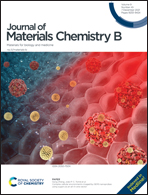A tyrosinase-responsive tumor-specific cascade amplification drug release system for melanoma therapy†
Abstract
Tumor-selective drug delivery could enhance anticancer efficacy and avoid drug side effects. However, because of tumor heterogeneity, current nanoparticle-based drug delivery systems rarely improve clinical outcomes significantly, commonly only reducing systemic toxicity. In this work, a new tumor-specific, tyrosinase-responsive cascade amplification release nanoparticle (TR-CARN) was developed to fulfill the needs for tumor-specific drug delivery and high efficacy cancer treatment. Tyrosinase (Tyr) is specifically expressed in melanomas and can catalyze acetaminophen (APAP) to increase reactive oxygen species (ROS). It was therefore utilized here to initiate the ROS amplification procedure. In TR-CARN, a ROS-responsive prodrug BDOX was loaded into an amphiphilic polymer, and APAP was linked to the polymer through a ROS-cleavable thioether bond. TR-CARN caused reduced side effects during the delivery because of the low toxicity of BDOX. Once TR-CARN entered into the tumor, endogenous ROS triggered initial APAP and BDOX release. Tyr-mediated ROS synthesis by APAP then accelerated APAP and BDOX release and toxification. Consequently, TR-CARN achieved melanoma-specific treatment of high efficacy through the cascade amplification strategy with enhanced biosafety.



 Please wait while we load your content...
Please wait while we load your content...